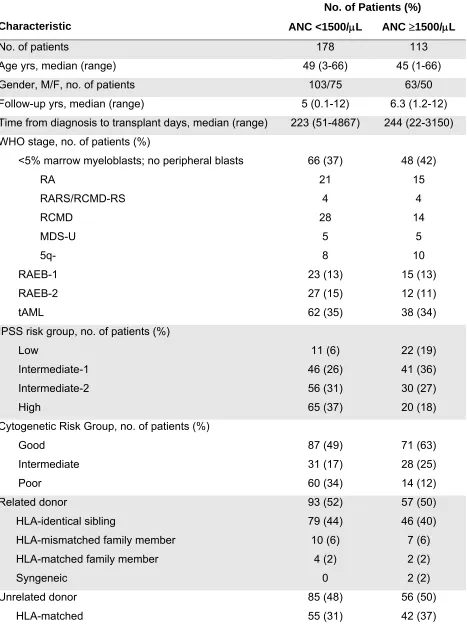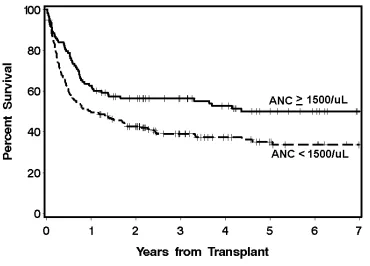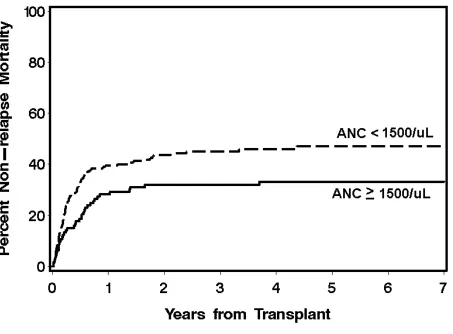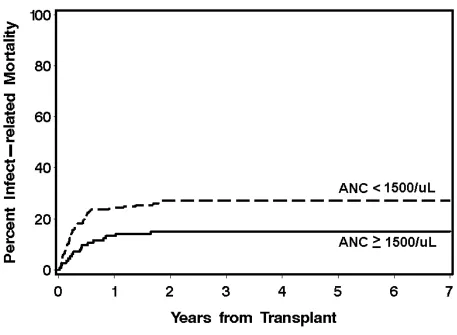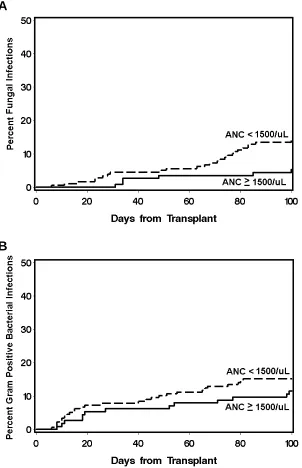Pre-transplant Neutropenia Is Associated with Poor Risk Cytogenetic Features and Increased Infection-related Mortality in Patients with Myelodysplastic Syndromes
Bart L. Scott1, 2, J.Y. Park3, H. Joachim Deeg1,2, Kieren A. Marr1,4, Michael Boeckh1,2, Thomas R. Chauncey1,2,5, Frederick R. Appelbaum1,2, Rainer Storb1,2, and Barry E. Storer1,2
1Fred Hutchinson Cancer Research Center, 2University of Washington School of Medicine,
Seattle, Washington, 3Kangdong Sacred Heart Hospital Seoul, Korea, 4Oregon Health & Science University, Portland Oregon, and 5VA Puget Sound Healthcare System, Seattle, Washington
Supported in part by grants HL084054, HL36444, CA18029, CA15704, and HL82941 from the National Institutes of Health, Bethesda, MD.
Correspondence and reprint requests: Bart L. Scott, MD, Fred Hutchinson Cancer Research Center, 1100 Fairview Avenue N, D1-100, PO Box 19024, Seattle, WA 98109-1024 (email: bscott@fhcrc.org).
Running Title: Neutropenia impacts transplant outcomes in MDS
Word Count: Abstract: 191 Total Text: 3,027
ABSTRACT
A retrospective cohort analysis was performed to determine the impact of neutropenia on the outcome of hematopoietic cell transplantation (HCT) in patients with myelodysplasia (MDS). Among 291 consecutive patients, 178 (61%) had absolute neutrophil counts (ANCs) <1500/µL and 113 (39%) had ANCs ≥1500/µL within 2 weeks before HCT. Neutropenic patients more often had poor risk karyotypes (34% vs. 12%, p<0.0001) and high risk IPSS scores (37% vs. 18%, p=0.0006). After HCT, the rate of infections caused by gram-positive bacteria and invasive fungal infections was significantly increased among neutropenic patients (rate ratio [RR] 1.77, p=0.02 and RR=2.56, p=0.03, respectively), while infections caused by gram-negative bacteria were not affected (RR 1.33, p=0.53). The hazards of non-relapse mortality (NRM) [HR=1.62 (1.1-2.4), p=0.01], overall mortality [HR=1.55 (1.1-2.1), p=0.007], and infection-related mortality [HR=2.22 (1.2-4.2), p=0.01] were increased in neutropenic patients, while relapse, engraftment, and graft-versus-host-disease were not affected. After adjusting for cytogenetic risk and marrow myeloblast percentages, neutropenic patients remained at significant hazard for infection-related mortality [HR=1.94 (1.0-3.8), p=0.05], but not for overall mortality or NRM. We propose that intensified strategies to prevent infections should be implemented in MDS patients with pre-existing neutropenia who undergo HCT.
INTRODUCTION
Neutropenia has been previously defined as an absolute neutrophil count (ANC) less than two standard deviations below the normal mean of the population, usually <1500/µL. The actual numerical value of neutropenia is dependent upon age, ethnic group, and other genetic and environmental factors [1]. Neutropenia is a frequent problem in patients with
Myelodysplastic Syndromes (MDS) and is either a primary result of marrow failure or develops secondary to therapy. Among the International Prognostic Scoring System (IPSS) cohort of 805 patients with primary MDS who had ANC data available, 366 (46%) had ANCs <1500/µL [2]. Patients with neutropenia have an increased risk of developing infections, and the risk and type of infections depend on the severity and duration of neutropenia [3,4]. The ability to assess neutropenia as an isolated risk factor in MDS is limited. The World Health Organization’s (WHO) diagnostic schemata do not have a separate classification system based solely upon the type of cytopenia(s) present [5]. While the IPSS does score the number of cytopenias, it does not consider the type or the severity of cytopenias present [2]. Furthermore, patients with MDS may have increased risks of infectious complications above and beyond the severity of neutropenia as they can have both quantitative and qualitative defects in neutrophil function [6]. Other investigators have shown that neutropenic patients with a diagnosis of MDS or acute myeloid leukemia (AML) have increased risks for invasive aspergillosis in comparison to neutropenic patients without these disorders, thus indicating that it is not only the development of
secondary to increased use of pre-transplant antibiotics or due to sustained impairment of immune functions following engraftment.
Given the current lack of information, we performed a retrospective cohort analysis to characterize the effects of pre-transplant neutropenia on post-transplant outcomes. Additionally, we were interested in characterizing associations between neutropenia and other known
predictors of survival.
MATERIALS AND METHODS
We performed a retrospective cohort analysis of results in 291 consecutive patients with a diagnosis of MDS or AML with multilineage dysplasia transformed from a prior diagnosis of MDS (tAML). Chronic myelomonocytic leukemia patients were excluded from this analysis. All patients received their allogeneic hematopoietic stem cell transplants (HCT) between January, 1994 and December, 2003 at the Fred Hutchinson Cancer Research Center (FHCRC) or the VA Puget Sound Healthcare System. All patients were enrolled in IRB approved protocols active at time of enrollment. One-hundred-seventy-eight patients (61%) had ANCs <1500/µL
groups in regards to distribution by median follow-up, median age, gender, or etiology of MDS/tAML (Table 1). Additionally, the distribution by WHO diagnostic categories was similar between the two groups. However, patients with neutropenia were more likely to be in the IPSS high risk group (65% vs. 17.7%, p=0.0006) and this was primarily due to the presence of poor risk cytogenetics (33.7% vs. 12.4%, p<0.0001) [2].
All patients included in this analysis received myeloablative HCT conditioning. In most patients this consisted of busulfan (Bu), prescribed dose 16 × 1 mg/kg, dose-adjusted to achieve target steady state levels of 600-900 ng/mL (tBu), plus cyclophosphamide (Cy), 2 × 60 mg/kg (Table 1) [8]. The remaining patients were conditioned with tBu combined with
fludarabine, 4 × 30 mg/m2; Cy 2 × 60 mg/kg plus 12-14.4 Gy total-body irradiation (TBI); tBu, Cy 2 × 60 mg/kg plus 12 Gy TBI; Bu (7 mg/kg) plus 12 Gy TBI; or myeloablative doses of
radiolabeled I131 [9
-
13]. Stem cells were infused within 24 hours of completion of TBI or within36-48 hours of the last dose of chemotherapy. All recipients received T-replete grafts. There were no differences between the two cohorts in regards to donor source, donor HLA-matching, and stem cell source. ABO incompatible grafts underwent red blood cell depletion or plasma reduction depending on pre-transplant recipient/donor ABO isoagglutinin titers.
The majority of the neutropenic patients (84%) and non-neutropenic patients (70%) received intravenous methotrexate and cyclosporine for graft versus host disease (GVHD) prophylaxis [14]. Acute GVHD was diagnosed and graded according to consensus criteria [15]. Chronic GVHD was diagnosed as clinically limited or extensive (requiring immunosuppressive therapy) using previously published criteria [16,17].
Infection Surveillance and Prophylaxis
patients developed a fever (>38.3°C orally). Additionally, all patients receiving ≥0.5 mg/kg of corticosteroid therapy were monitored with weekly bacterial and fungal blood cultures and chest radiographs. For Pneumocystis jiroveci prophylaxis all patients received
trimethoprim/sulfamethoxasole as first line therapy, dapsone as second line therapy [18], or atovaquone as third line therapy from time of engraftment until 6 months after HCT or until 6 weeks after all immunosuppressive medications had been discontinued. All patients received fluconazole or itraconazole for prevention of candidiasis from time of conditioning until day 75 after HCT [19]. Prophylactic systemic antibiotics with levofloxacin or ceftazidime [20] were initiated in all patients when their ANCs fell below 500/µL.
Definitions of Endpoints
The day of onset of infection was defined as the day the diagnostic test was performed [21]. Invasive fungal infections were defined by the National Institutes of Health Mycosis Study Group/European Organization for Research and Treatment of Cancer consensus criteria [22]. Bacterial infections were defined as positive blood, bronchial lavage (lower respiratory tract), or urine cultures. The day of engraftment was defined as the first of 3 consecutive days on which the ANC remained greater than 500/µL. Evidence of graft rejection was sought in patients who failed to reach ANCs of 500/µL by day 28, and in patients with sustained declines in counts after
initial recovery. All patients had marrow evaluations scheduled on days 28, 56, 84 (±3 days),
and one year after HCT, and subsequently as clinically indicated. Relapse was defined as post-transplant reappearance of dysplastic cells by flow cytometry, morphologic evidence of
therapy who subsequently died with infections, GVHD was considered the cause of death. Multiorgan failure was identified as the cause of death when it occurred in the absence of relapse and was thought not to be primarily due to preceding GVHD or infection. Graft rejection was considered the cause of death if patients had documented loss of graft function after day 28 post-transplant without evidence of relapse or GVHD. Infections were considered causes of death when they occurred in the absence of GVHD, relapse, graft failure, and graft rejection. The coding of death was performed by reviewing autopsy and other medical documents by a single investigator (B.L.S.) who was blinded to the cohort assignment.
Statistical Analysis
cohorts in regards to other potential confounding variables such as age, etiology, GVHD prophylaxis, stem cell source, donor type, and conditioning regimen.
RESULTS
Among the 178 patients with pre-transplant neutropenia, 7 (4%) died before day 28 without evidence of GVHD and were considered not evaluable for engraftment. An additional 5 patients (3%) died with graft failure or graft rejection at 38 to 343 days. The median time to neutrophil engraftment in the remaining 166 patients was 17 (range: 10-31) days. There were no differences observed in median engraftment by severity of neutropenia (ANC 1500-1000/µL, 1000-500/µL, and <500/µL). Among the 113 patients without pre-transplant neutropenia, 6 patients (5%) died before day 28 without evidence of GVHD and were considered not evaluable for engraftment. One patient (1%) died with graft failure at 46 days. The median time to
engraftment in the remaining 106 patients was 17 (range: 10-33) days.
The cumulative incidences of grades II-IV GVHD were not different between the neutropenic (80%) and the non-neutropenic cohorts (76%) (p=0.42), nor were the cumulative incidences of grades III-IV GVHD (32% vs. 24%, p=0.15). The 3-year overall survival was 39.7% for the neutropenic cohort and 55.7% for the non-neutropenic cohort (Figure 1). The decreased overall survival observed in the neutropenic cohort was chiefly secondary to differences in NRM. The neutropenic cohort had higher incidences of NRM than the non-neutropenic cohort, 24.4% vs. 14.3% and 39.6% vs. 26.7% at day 100 and 1 year, respectively (Figure 2). Specifically, the neutropenic cohort had an increased incidence of infection-related mortality at 3 years in comparison to the non-neutropenic cohort (26% vs. 12.3%) (Figure 3). The 3-year cumulative incidences of relapse were similar between the two cohorts, 20.3% and 19.3%, respectively.
have poor risk cytogenetics and an overall higher IPSS classification. Therefore, adjusted analyses were performed using cytogenetic risk and marrow myeloblast percentages as detailed in the statistical section. Following adjustment, the neutropenic cohort no longer had significantly higher hazards for overall survival or NRM; however, the hazard for infection-related mortality remained significantly higher.
We also evaluated whether the hazards of NRM, mortality, and relapse increased with increasing degrees of neutropenia. To that end, neutropenic patients were compared to non-neutropenic patients using ANC cut-offs of 1000-1500/µL (n=41), 500-1000/µL (n=51), and <500/µL (n=86). There was no increased risk of poor HCT outcomes with increasing severity of neutropenia (data not shown).
Time from diagnosis to HCT had no effect on infection-related mortality; however, the distribution was highly skewed towards a short time interval from diagnosis to HCT: 75% of the patients in both neutropenic and non-neutropenic cohorts were transplanted within 500 days of diagnosis.
Types of Post-transplant Infections
Overall, the neutropenic cohort had significantly increased rates of bacterial and fungal infections in comparison to non-neutropenic patients within the first 100 days after HCT
(RR=1.59, p=0.001 and RR=2.89, p=0.01, respectively) (Table 2). Most fungal infections were caused by Aspergillus species (27/32), and the remaining fungal infections were due to Candida glabrata (2/32) and mucor (3/32). The propensity for neutropenic patients to develop bacterial infections varied by type of organism. There was an increase in the rate of infections with gram positive organisms (RR=1.77, p=0.02), but not with gram negative rods. The increased rate of fungal and gram positive bacterial infections among the neutropenic patients was most
indicating there was no evidence of confounding by acute GVHD. There was no association between pre-transplant colonization with bacteria or fungal organisms and the subsequent development of bacterial or invasive fungal infections; however, these data are limited by the fact that no routine surveillance for colonization was employed. The increasing levels of neutropenia (ANC 1500-1000/µL, 1000-500/µL, and <500/µL) had no further significant impact on an increased risk of fungal and bacterial infections using a test for trend (data not shown).
Effects of Single Lineage Pre-Transplant Cytopenias
Among the patients evaluated in these analyses, there were 16 (4.6%) with isolated neutropenia (ANC<1500/µL), 22 (6.3%) with isolated thrombocytopenia (platelet count <100,000/µL), and 25 (7.1%) with isolated anemia (Hgb <10g/dL). Given the inferior HCT outcomes observed with neutropenia, we were interested in determining whether isolated neutropenia was associated with worse HCT outcomes than observed in patients with other single lineage cytopenias. Patients with each of the isolated cytopenias were compared to patients without cytopenias (n=32) using proportional hazards regression and adjusted for cytogenetic risk and marrow myeloblast percentages (Table 3). Although the numbers of patients within the subgroups were small, there was a strong trend for an increased risk of worse outcomes among patients with isolated neutropenia and thrombocytopenia.
DISCUSSION
correlation of neutropenia and poor risk cytogenetics may be due to a referral bias. Biologically, an association of poor risk cytogenetics with an overall decrease in marrow function in MDS patients appears plausible, but this possibility has not been examined systematically.
Pre-transplant neutropenia was associated with significantly increased hazards of NRM, overall mortality and infection-related mortality. Of note, the hazard did not increase significantly with the severity of neutropenia. There may be a critical level of neutropenia combined with intrinsic abnormalities in the neutrophils that confers the increased risk of infectious
complications; therefore, increasing levels of neutropenia did not results in increased risk of infectious complications. However, there were few patients in this subgroup analysis and it is possible that we were not able to detect a difference due to lack of power. Neutropenic patients were not found to be at an increased risk of relapse-related mortality despite adverse factors such as poor risk cytogenetics and increased IPSS scores. The increased rate of earlier NRM may have removed the neutropenic patients from a later risk of relapse. Following adjustment for IPSS cytogenetic classification and marrow myeloblast percentage, the neutropenic cohort no longer showed a significantly increased hazard for overall mortality and NRM, but the increased hazard for infection-related mortality remained significant.
Overall, neutropenic patients were at an increased risk of developing bacterial and invasive fungal infections in comparison to non-neutropenic patients. The median time to engraftment was similar between the neutropenic and non-neutropenic patients. Furthermore, there was no difference in median engraftment with increasing severity of neutropenia. Therefore, it is unlikely that the difference in infection rates were secondary to differences in engraftment. The types of bacterial infections that developed in neutropenic patients tended to be different from those in non-neutropenic patients. Neutropenic patients more frequently developed infections with gram positive organisms rather than gram negative organisms.
among patients with pre-transplant neutropenia was most prominent after day 60 post-transplant, thereby indicating a possible multiplicative association between pre-transplant neutropenia and therapy for GVHD (generally with steroids) with invasive fungal infections.
The time from diagnosis to HCT in neutropenic patients was thought to be an important predictor of NRM and specifically infection-related mortality. With increased time, it was
suspected that increased colonization would result in increased rates of death from infection in the neutropenic cohort as compared to the non-neutropenic cohort. However, as specified in the results section the time from diagnosis to HCT was highly skewed towards a short time interval for both cohorts (<500 days), and we were not able to adequately address this issue because of a lack of discordance between the neutropenic and non-neutropenic cohorts. Since we studied only patients who underwent HCT, we cannot comment on outcome for neutropenic patients treated with other modalities. Neutropenic patients who had a long delay between diagnosis and consideration of HCT may have developed serious infectious complications that precluded the option of and referral for HCT.
ACKNOWLEDGMENTS
REFERENCES
1. Dale DC. Neutropenia and neutrophilia. In: Lichtman MA, Beutler E, Kipps TJ, Seligsohn U, Kaushansky K, Prchal JT, eds. Williams Hematology. New York, NY: The McGraw-Hill Companies, Inc.; 2006;907 -919.
2. Greenberg P, Cox C, LeBeau MM, et al. International scoring system for evaluating prognosis in myelodysplastic syndromes (erratum appears in Blood 1998 Feb 1;91(3):1100). Blood. 1997;89:2079-2088.
3. Engels EA, Ellis CA, Supran SE, et al. Early infection in bone marrow transplantation: quantitative study of clinical factors that affect risk. Clin Infect Dis. 1999;28:256-266. 4. Viscoli C, Varnier O, Machetti M. Infections in patients with febrile neutropenia:
epidemiology, microbiology, and risk stratification (Review). Clin Infect Dis. 2005;40 (Suppl. 4):S240-S245.
5. Vardiman JW, Harris NL, Brunning RD. The World Health Organization (WHO) classification of the myeloid neoplasms (Review). Blood. 2002;100:2292-2302. 6. Yamaguchi N, Ito Y, Ohyashiki K. Increased intracellular activity of matrix
metalloproteinases in neutrophils may be associated with delayed healing of infection without neutropenia in myelodysplastic syndromes. Ann Hematol. 2005;84:383-388. 7. Mühlemann K, Wenger C, Zenhäusern R, Täuber MG. Risk factors for invasive
aspergillosis in neutropenic patients with hematologic malignancies. Leukemia. 2005;19:545-550.
8. Deeg HJ, Storer B, Slattery JT, et al. Conditioning with targeted busulfan and
cyclophosphamide for hemopoietic stem cell transplantation from related and unrelated donors in patients with myelodysplastic syndrome. Blood. 2002;100: 1201-1207.
10. Anderson JE, Appelbaum FR, Schoch G, et al. Allogeneic marrow transplantation for myelodysplastic syndrome with advanced disease morphology: a phase II study of
busulfan, cyclophosphamide, and total-body irradiation and analysis of prognostic factors. J Clin Oncol. 1996;14:220-226.
11. Jurado M, Deeg HJ, Storer B, et al. Hematopoietic stem cell transplantation for advanced myelodysplastic syndrome after conditioning with busulfan and fractionated total body irradiation is associated with low relapse rate but considerable nonrelapse mortality. Biol Blood Marrow Transplant. 2002;8:161-169.
12. Bornhauser M, Storer B, Slattery JT, et al. Conditioning with fludarabine and targeted busulfan before transplantation of allogeneic hematopoietic stem cells. Blood. 2002;100 (Part 1):213a, #799 [abstr.]
13. Pagel JM, Appelbaum FR, Eary JF, et al. 131 I-anti-CD45 antibody plus busulfan and cyclophosphamide before allogeneic hematopoietic cell transplantation for treatment of acute myeloid leukemia in first remission. Blood. 2006;107:2184-2191.
14. Storb R, Deeg HJ, Whitehead J, et al. Methotrexate and cyclosporine compared with cyclosporine alone for prophylaxis of acute graft versus host disease after marrow transplantation for leukemia. N Engl J Med. 1986;314:729-735.
15. Przepiorka D, Weisdorf D, Martin P, et al. 1994 Consensus conference on acute GVHD grading. Bone Marrow Transplant. 1995;15:825-828.
16. Sullivan KM, Shulman HM, Storb R, et al. Chronic graft-versus-host disease in 52 patients: adverse natural course and successful treatment with combination immunosuppression. Blood. 1981;57:267-276.
18. Sangiolo D, Storer B, Nash R, et al. Toxicity and efficacy of daily Dapsone as
pneumocystis jiroveci prophylaxis after hematopoietic stem cell transplantation: a
case-control study. Biol Blood Marrow Transplant. 2005;11:521-529.
19. Marr KA, Crippa F, Leisenring W, et al. Itraconazole versus fluconazole for prevention of fungal infections in allogeneic stem cell transplant patients. Blood. 2004;103:1527-1533. 20. Hakki M, Limaye AP, Kim HW, Kirby KA, Corey L, Boeckh M. Invasive pseudomonas
aeruginosa infections: high rate of recurrence and mortality after hematopoietic cell
transplantation. Bone Marrow Transplant. 2007;39:687-693.
21. Crippa F, Holmberg L, Carter RA, et al. Infectious complications after autologous CD34-selected peripheral blood stem cell transplantation. Biol Blood Marrow Transplant. 2002;8:281-289.
22. Ascioglu S, Rex JH, de Pauw B, et al. Defining opportunistic invasive fungal infections in immunocompromised patients with cancer and hematopoietic stem cell transplants: an international consensus. Clin Infect Dis. 2002;34:7-14.
23. Deeg HJ, Shulman HM, Anderson JE, et al. Allogeneic and syngeneic marrow
transplantation for myelodysplastic syndrome in patients 55 to 66 years of age. Blood. 2000;95:1188-1194.
24. Sievers EL, Lange BJ, Buckley JD, et al. Prediction of relapse of pediatric acute myeloid leukemia by use of multidimensional flow cytometry. J Natl Cancer Inst. 1996;88:1483-1488.
26. Chien JW, Boeckh M, Hansen JA, Clark JG. Lipopolysaccharide binding protein promoter variants influence the risk for gram-negative bacteremia and mortality after allogeneic hematopoietic cell transplantation. Blood; prepublished online December 3, 2007; DOI 10.1182/blood-2007-09-101709-
Table 1. Patient, Disease and Transplant Characteristics
No. of Patients (%)
Characteristic ANC <1500/μL ANC ≥1500/μL
No. of patients 178 113
Age yrs, median (range) 49 (3-66) 45 (1-66)
Gender, M/F, no. of patients 103/75 63/50
Follow-up yrs, median (range) 5 (0.1-12) 6.3 (1.2-12) Time from diagnosis to transplant days, median (range) 223 (51-4867) 244 (22-3150) WHO stage, no. of patients (%)
<5% marrow myeloblasts; no peripheral blasts 66 (37) 48 (42)
RA 21 15
RARS/RCMD-RS 4 4
RCMD 28 14
MDS-U 5 5
5q- 8 10
RAEB-1 23 (13) 15 (13)
RAEB-2 27 (15) 12 (11)
tAML 62 (35) 38 (34)
IPSS risk group, no. of patients (%)
Low 11 (6) 22 (19)
Intermediate-1 46 (26) 41 (36)
Intermediate-2 56 (31) 30 (27)
High 65 (37) 20 (18)
Cytogenetic Risk Group, no. of patients (%)
Good 87 (49) 71 (63)
Intermediate 31 (17) 28 (25)
Poor 60 (34) 14 (12)
Related donor 93 (52) 57 (50)
HLA-identical sibling 79 (44) 46 (40)
HLA-mismatched family member 10 (6) 7 (6)
HLA-matched family member 4 (2) 2 (2)
Syngeneic 0 2 (2)
Unrelated donor 85 (48) 56 (50)
Table 1. Patient, Disease and Transplant Characteristics
No. of Patients (%)
Characteristic ANC <1500/μL ANC ≥1500/μL
HLA-mismatched 30 (17) 14 (13)
Source of stem cells
Peripheral blood 92 (52) 51 (45)
Marrow 86 (48) 61 (54)
Cord blood 0 1 (1)
Conditioning regimen
tBuCy 99 (56) 74 (65)
BuFlu 13 (7) 4 (4)
BuTBI 35 (20) 10 (9)
CyTBI 28 (15) 22 (19)
I-131 3 (2) 2 (2)
MelBu 0 1 (1)
*Syngeneic donor.
Abbreviations: Bu, busulfan; CSP, cyclosporine; Cy, cyclophosphamide; FK506, tacrolimus; Flu, fludarabine; I-131, radio-iodine labeled monoclonal antibody; IPSS, International
Table 2. Hazard Ratios and Rate Ratios Comparing Neutropenic and Non-neutropenic Cohorts
ANC <1500/μL ANC <1500/μL Adjusted
Outcomes HR (95% CI) P-value HR (95% CI)* P-value*
Overall Mortality 1.55 (1.1-2.1) 0.007 1.19 (0.8-1.7) 0.34
Non-relapse mortality (NRM) 1.62 (1.1-2.4) 0.01 1.31 (0.9-2.0) 0.2
Relapse 1.31 (0.8-2.3) 0.33 0.96 (0.5-1.8) 0.9
Infection-related mortality 2.22 (1.2-4.2) 0.01 1.94 (1.0-3.8) 0.05
RR (95% CI) P-value RR (95% CI)† P-value†
Bacterial infection‡ (223 in 60 pts) 1.59 (1.2-2.1) 0.001 1.42 (1.1-1.9) 0.01
Gram-negative rods (21 in 11 pts) 1.33 (0.5-3.3) 0.53 1.27 (0.5-3.2) 0.6
Gram-positive organisms§ (84 in 37 pts) 1.77 (1.1-2.9) 0.02 1.51 (0.9-2.1) 0.09
Coagulase-negative staph (102 in 40 pts) 1.46 (1.0-2.2) 0.07 1.35 (0.9-2.1) 0.16
Bacillus and Corynebacterium (8 in 6 pts) ////¶ 0.004 N/A N/A
Fungal infection‡ (32 in 31 pts) 2.89 (1.2-7.0) 0.01 2.89 (1.2-7.0) 0.01
* Adjusted for cytogenetic risk group and bone marrow myeloblast percentage.
† Adjusted for TBI conditioning and CMV recipient + vs. – for bacterial infections or HLA-matched related donor vs. other and age ≤ or > 40 years for fungal infections.
‡ All infection rates estimated using Poisson regression, truncated at death or day 100. § Excluding Coagulase-negative staph, Bacillus and Corynebacterium.
Table 3. Hazard Rate Ratios* Comparing Isolated Cytopenic Patients to Patients without Any Cytopenias (n=32)
Outcomes ANC <1500/μL
n=16
Platelets <100,000/μL
n=22
Hgb <10 g/dL
n=25
HR (95% CI) P-value HR (95% CI) P-value HR (95% CI) P-value
Overall mortality 2.39 (0.9-6.1) 0.07 2.25 (0.9-5.6) 0.08 1.25 (0.5-2.9) 0.6
NRM 2.96 (1-8.6) 0.05 3.49 (1.1-11) 0.03 1.52 (0.5-4.6) 0.45
Relapse /////† 0.08 0.46 (0.1-3.1) 0.43 1.09 (0.3-4.3) 0.9
Infection-related 8.19 (0.8-86) 0.08 6.22 (0.6-66) 0.13 5.67 (0.6-54) 0.13
* Adjusted for cytogenetic risk group and bone marrow myeloblast percentage. † No events occurred in the isolated neutropenic cohort.
Figure 1. Overall survival among neutropenic (ANC <1500/µL) and non-neutropenic (ANC
